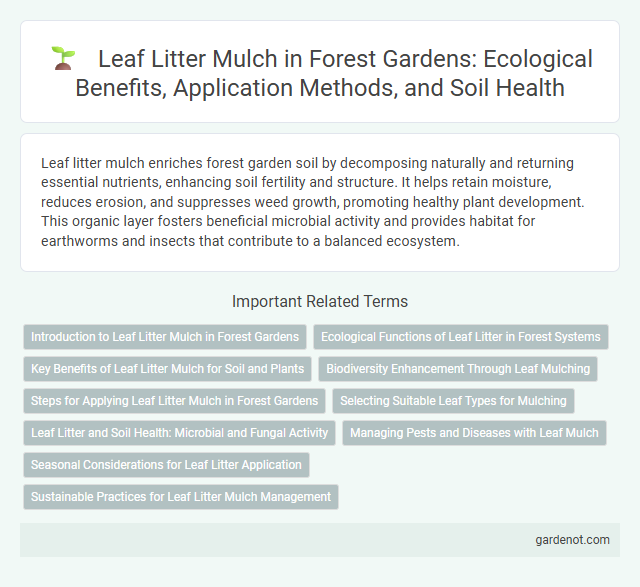Leaf litter mulch enriches forest garden soil by decomposing naturally and returning essential nutrients, enhancing soil fertility and structure. It helps retain moisture, reduces erosion, and suppresses weed growth, promoting healthy plant development. This organic layer fosters beneficial microbial activity and provides habitat for earthworms and insects that contribute to a balanced ecosystem.
Introduction to Leaf Litter Mulch in Forest Gardens
Leaf litter mulch in forest gardens acts as a natural protective layer, enhancing soil moisture retention and reducing erosion by covering the ground with decomposing leaves. This mulch enriches soil fertility through nutrient cycling, fostering beneficial microbial activity and supporting plant health. Its organic composition also suppresses weed growth, promoting a sustainable and low-maintenance ecosystem within the garden.
Ecological Functions of Leaf Litter in Forest Systems
Leaf litter mulch plays a vital role in maintaining soil fertility within forest gardens by enhancing nutrient cycling through the gradual decomposition of organic matter, which releases essential minerals like nitrogen, phosphorus, and potassium. This natural mulch fosters microbial diversity and activity, promoting healthy soil structure and water retention critical for plant growth. Furthermore, leaf litter acts as a protective barrier against erosion and temperature fluctuations, supporting a stable microclimate that benefits understory vegetation and overall forest ecosystem resilience.
Key Benefits of Leaf Litter Mulch for Soil and Plants
Leaf litter mulch enriches soil fertility by decomposing into organic matter that enhances nutrient availability and soil structure. It conserves moisture, reducing evaporation and sustaining optimal hydration for plant roots. This mulch also suppresses weeds and supports beneficial microbial activity, promoting healthier plant growth in forest gardens.
Biodiversity Enhancement Through Leaf Mulching
Leaf litter mulch significantly boosts biodiversity in forest gardens by creating a rich, organic ground cover that supports diverse microbial communities and soil fauna such as earthworms and insects. This natural mulch layer provides habitat and food resources for various organisms, enhancing nutrient cycling and soil health. Increased biodiversity from leaf mulching leads to more resilient ecosystems capable of better supporting plant growth and pest control.
Steps for Applying Leaf Litter Mulch in Forest Gardens
Spread a 2 to 4-inch layer of leaf litter mulch evenly around the base of plants in the forest garden, avoiding direct contact with stems to prevent rot. Ensure the mulch covers the soil surface completely to suppress weeds, retain moisture, and gradually decompose, enriching the soil with organic matter and nutrients. Regularly replenish the leaf litter mulch layer as it breaks down, particularly during early spring and fall, to maintain its protective and soil-enhancing benefits.
Selecting Suitable Leaf Types for Mulching
Leaf litter mulch plays a crucial role in forest gardens by enriching soil fertility and retaining moisture. Selecting suitable leaf types like oak, maple, and beech, known for their slow decomposition and nutrient-rich properties, enhances soil health and supports beneficial microorganisms. Avoiding allelopathic leaves, such as black walnut or eucalyptus, prevents harmful effects on plant growth and maintains garden productivity.
Leaf Litter and Soil Health: Microbial and Fungal Activity
Leaf litter mulch enhances soil health by providing a rich source of organic matter that stimulates microbial and fungal activity essential for nutrient cycling. The decomposition of leaf litter fosters a diverse community of beneficial microbes and mycorrhizal fungi, which improve soil structure and increase nutrient availability for plants in forest gardens. This natural process supports soil fertility, moisture retention, and plant resilience, creating a sustainable ecosystem.
Managing Pests and Diseases with Leaf Mulch
Leaf litter mulch acts as a natural barrier, reducing the habitat for pests by covering the soil and disrupting their life cycles. It enhances soil health by promoting beneficial microorganisms that suppress harmful pathogens, thereby decreasing disease incidence. This organic layer also helps retain moisture and regulate temperature, creating a resilient environment that supports plant immunity against pests and diseases.
Seasonal Considerations for Leaf Litter Application
Leaf litter mulch varies in composition and nutrient content across seasons, with autumn providing the richest source due to fallen deciduous leaves. Applying leaf litter mulch in early spring aids soil moisture retention and temperature regulation, enhancing root development during critical growth stages. Avoid thick layers in winter to prevent moisture trapping and potential fungal growth, ensuring balanced decomposition and soil enrichment throughout the year.
Sustainable Practices for Leaf Litter Mulch Management
Leaf litter mulch enhances soil fertility by slowly decomposing and returning essential nutrients such as nitrogen, phosphorus, and potassium to the forest garden ecosystem. Sustainable management involves regularly monitoring thickness to prevent smothering young plants while maintaining adequate coverage to conserve moisture and suppress weeds. Utilizing locally sourced leaf litter reduces carbon footprint and supports biodiversity by providing habitat for beneficial microorganisms and insects.
Leaf litter mulch Infographic

 gardenot.com
gardenot.com